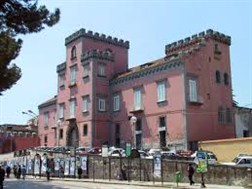The possessions in Campania: the fief of Sant’Antimo
 In 1629, the Ruffo di Bagnara acquired the fief of Sant’Antimo and kept it until 1756, when they sold it to Francesco Maria Mirelli. In 1641, Carlo Ruffo was able to have it named a principality by King Philip IV, allowing him and his successors the right to use the title of Prince of Sant ‘Antimo. A Renaissance building (as shown in the gallery in trachytic rock, the entrance hall and loggia) with architectural elements related to an original medieval structure (the central tower and the towers on the side), the castle is built on an elevated plan with respect to the surrounding buildings. The name of the architect or its original structure are unknown. Until the early 1800s it was surrounded by two gardens. The building was probably built between the sixteenth and the seventeenth century by Baron Francesco Revertera, Duke of Salandra, in the area where there was the medieval residence of the Stendardo family, the owners of the fief of Sant’Antimo until 1566. In 1629 Ippolito Revertera sold the fief and the castle of Sant’Antimo to Francesco Ruffo, Duke of Bagnara. The latter, in 1756, sold it to the Prince of Teora Francesco Maria Mirelli.
In 1629, the Ruffo di Bagnara acquired the fief of Sant’Antimo and kept it until 1756, when they sold it to Francesco Maria Mirelli. In 1641, Carlo Ruffo was able to have it named a principality by King Philip IV, allowing him and his successors the right to use the title of Prince of Sant ‘Antimo. A Renaissance building (as shown in the gallery in trachytic rock, the entrance hall and loggia) with architectural elements related to an original medieval structure (the central tower and the towers on the side), the castle is built on an elevated plan with respect to the surrounding buildings. The name of the architect or its original structure are unknown. Until the early 1800s it was surrounded by two gardens. The building was probably built between the sixteenth and the seventeenth century by Baron Francesco Revertera, Duke of Salandra, in the area where there was the medieval residence of the Stendardo family, the owners of the fief of Sant’Antimo until 1566. In 1629 Ippolito Revertera sold the fief and the castle of Sant’Antimo to Francesco Ruffo, Duke of Bagnara. The latter, in 1756, sold it to the Prince of Teora Francesco Maria Mirelli.
The palace has a C-shaped plan and is on three levels in the central body and on two levels in the lateral bodies, with a courtyard and garden on the bottom. From the entrance gate, through a doorway, you enter the courtyard, surrounded on two sides of the building and on the third by the wall that borders the garden. The interior elevations are characterized by the presence of an arcade on the ground floor and a gallery on the first floor with rounded arches in trachytic rock. Originally the facade was devoid of plaster, which was then added in the renovation of the late eighteenth century. With the abolition of the feudal system the palace and its grounds were purchased by private owners. The current appearance of the building dates back to the period 1793-1800, the period in which they were carried out substantial renovations.
